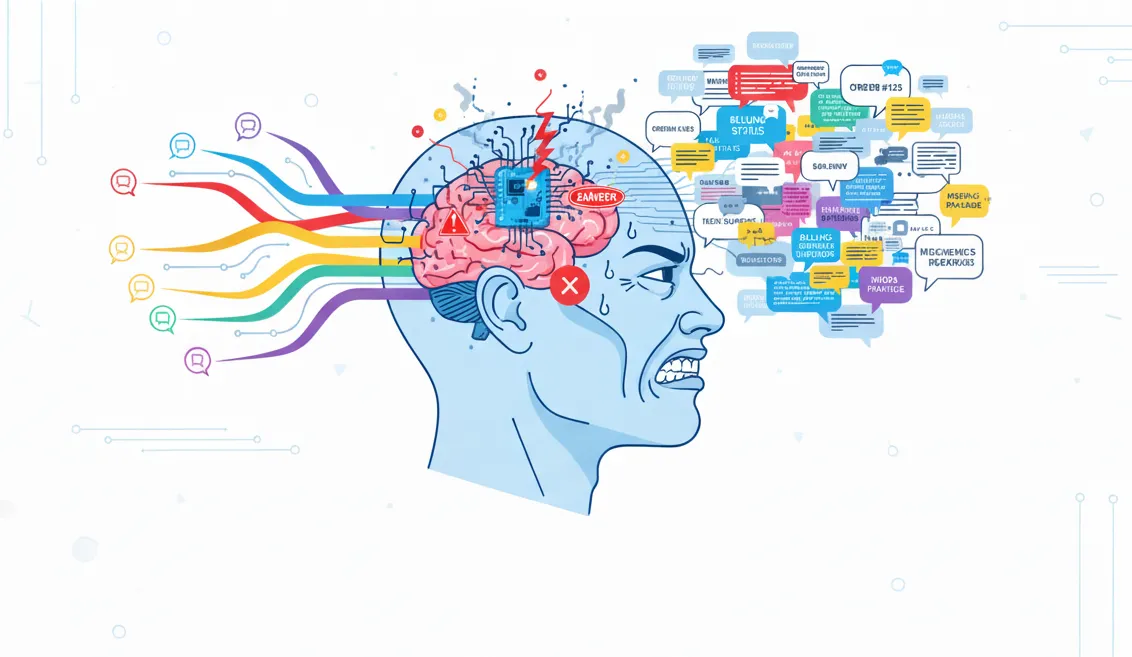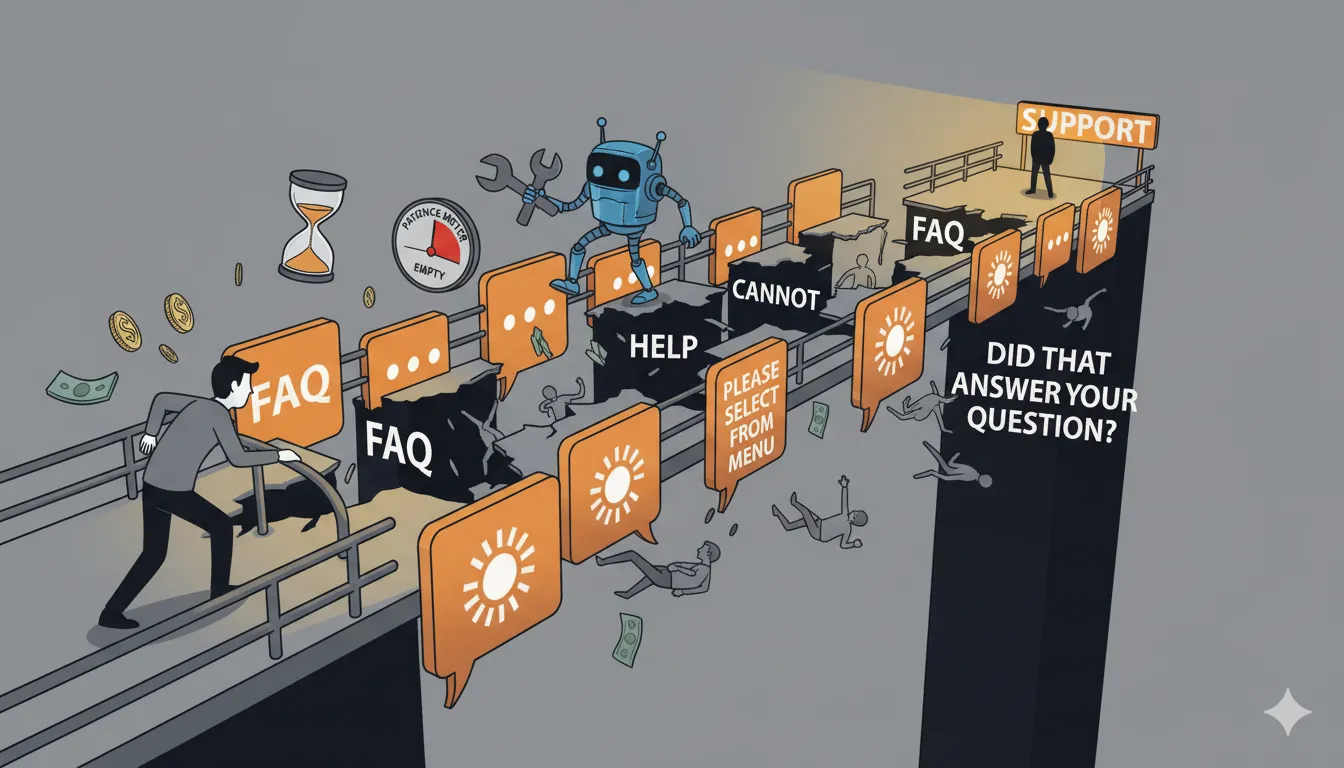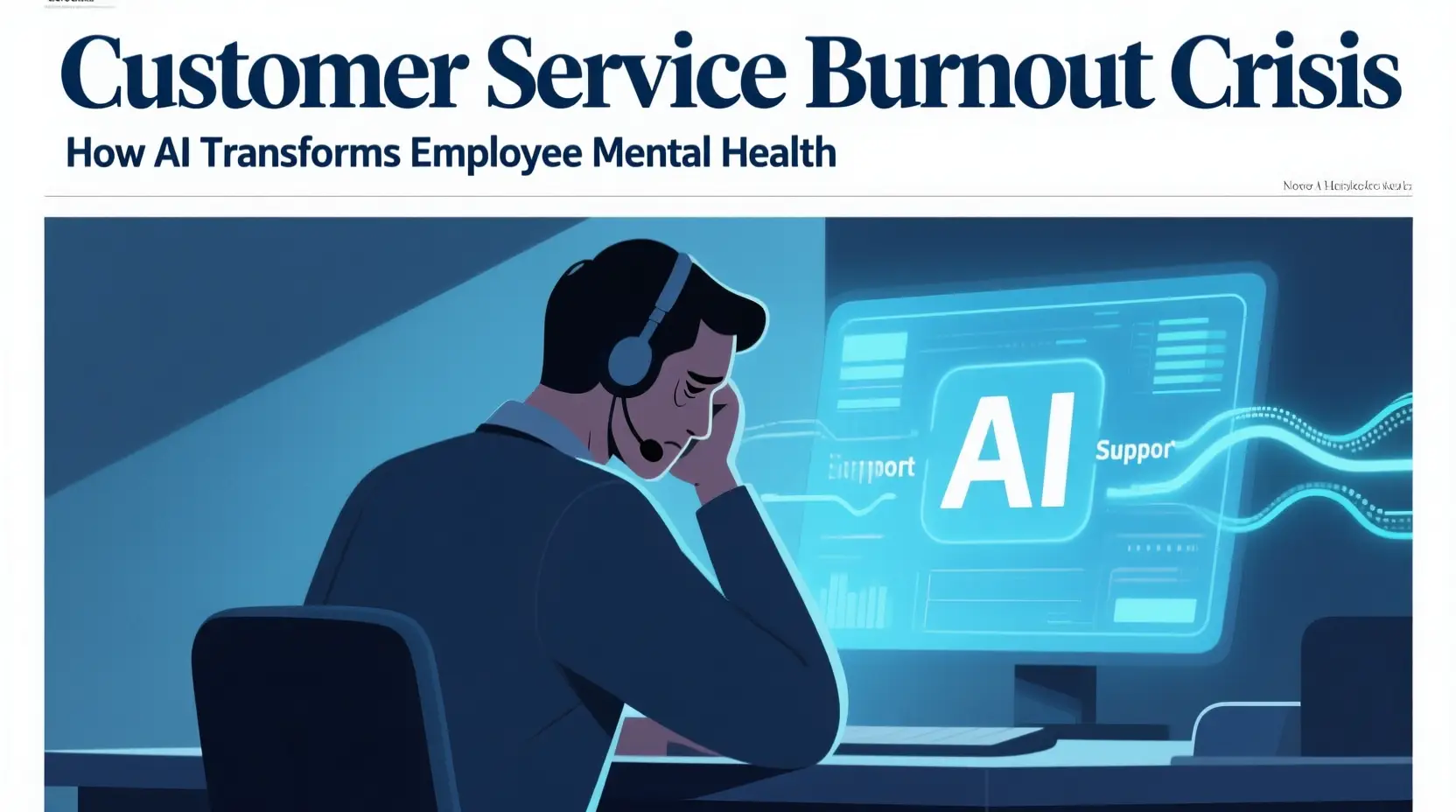The 5-Chat Burnout: Why Customer Service Is Breaking People (And How AI Fixes It)
A customer service representative just shared something that should concern every business leader:
“We take up to 5 live chats at a time, and it’s non-stop. Sometimes it’s 4 to 5 hours straight of juggling five angry customers at once… By the middle of the day, my brain feels completely fried. Everything starts to blur and feel dreamlike because of how much multitasking and mental strain it takes.”
This isn’t an isolated complaint. It’s a systematic problem with how modern customer service operates—and it’s costing businesses far more than they realize.
When your customer service model burns out employees in months, you’re not just facing a retention problem. You’re delivering terrible customer experiences while destroying employee wellbeing. And there’s a better way that benefits everyone.
The Math That Doesn’t Work
Let’s understand what “5 live chats simultaneously” actually means:
The expectation:
- Monitor 5 separate conversations in real-time
- Respond to each within 30-60 seconds
- Maintain context across all five discussions
- Sound polite, professional, and attentive in each
- Research issues, escalate problems, review cases
- Do this for 4-5 hours straight with only 30-minute break
The reality for the human brain:
Research on multitasking shows that humans can’t actually multitask—we rapidly switch between tasks, with switching costs each time:
- 40% productivity loss from task switching
- 50% more errors when juggling multiple tasks
- 300% increase in stress hormones during sustained multitasking
- Cognitive load comparable to losing a night’s sleep
The employee describes it perfectly: “My brain feels completely fried. Everything starts to blur and feel dreamlike.”
This isn’t weakness. This is the predictable result of asking humans to do something human brains aren’t designed to do.
Why Companies Do This (The Economics Are Obvious)
Traditional customer service math:
Option A: One chat per rep
- 100 daily customer inquiries
- Each takes 10 minutes average
- 1,000 minutes = 16.7 hours of work
- Need 2-3 full-time reps
- Cost: $80K-$120K annually in salaries
Option B: Five chats per rep
- Same 100 inquiries
- Handled “simultaneously” by 1 rep
- Responses take longer (switching costs), but customers wait in parallel
- Need 0.5-1 full-time reps
- Cost: $40K-$60K annually
The savings appear massive: 50-75% cost reduction.
What this calculation ignores:
Employee costs:
- Average tenure: 6-12 months before burnout
- Constant recruitment and training costs
- Performance deterioration over shift
- Sick days from stress-related issues
- Mental health impacts
Customer experience costs:
- Slower response times (despite “simultaneous” handling)
- More errors from cognitive overload
- Distracted, rushed interactions
- Frustrated customers escalating to supervisors
- Negative reviews mentioning poor support
Business impact costs:
- Lost customers due to poor support experience
- Increased refund/compensation costs
- Supervisor time spent on escalations
- Brand damage from support horror stories
The actual savings are far smaller—possibly negative—but they’re hidden across multiple budget lines.
The Specific Nightmare of Financial Services Support
The Reddit poster works for a brokerage company, which makes this worse:
“Most of the customers who come on chat are frustrated because it’s about money-related issues. These aren’t simple queries either. We have to review cases, investigate details, escalate to other teams.”
Why financial services is the worst environment for multi-chat:
High stakes:
- Customers are stressed about money
- Errors have serious consequences
- Regulatory compliance requirements
- Every interaction creates liability exposure
High complexity:
- Require detailed case review
- Need to investigate transaction history
- Often involve other departments
- Can’t be resolved with templates
High emotion:
- Money problems trigger fight-or-flight responses
- Customers are already frustrated before contact
- Small delays or errors escalate quickly
- Empathy is essential but impossible at scale
The employee is being asked to:
- Provide empathy to 5 angry people about money problems simultaneously
- Investigate complex financial issues under time pressure
- Avoid compliance errors while cognitively overloaded
- Maintain professional demeanor while internally breaking down
This isn’t a job. It’s an impossible situation dressed up as customer service.
The Hidden Costs of the Multi-Chat Model
What businesses think they’re getting:
- 5x productivity per employee
- Significant cost savings
- Efficient use of resources
What they’re actually getting:
1. Catastrophic Turnover
The poster writes: “I’m new here, only a few months in, and the only thing keeping me from quitting is that the company pays well and offers good benefits. After a year, I can apply internally to move to another department, but that feels so far away.”
Translation: This person is counting down days until escape. Most won’t last a year.
The turnover cycle:
- Month 1-2: Learning, manageable stress
- Month 3-4: Full workload, stress building
- Month 5-6: Burnout setting in, performance declining
- Month 6-12: Actively job hunting, mentally checked out
- Month 12+: Gone
Cost of replacing customer service rep:
- Recruitment: $3K-$5K
- Training: $2K-$4K
- Lost productivity during ramp: $5K-$8K
- Total: $10K-$17K per replacement
If average tenure is 9 months:
- Annual turnover: 133%
- Cost per position: $13K-$23K annually just for churn
That 50% “savings” from multi-chat just evaporated.
2. Declining Service Quality
“By the middle of the day, my brain feels completely fried. Everything starts to blur and feel dreamlike.”
What happens to service quality when reps are cognitively overloaded:
Error rates increase:
- Wrong information provided
- Cases escalated incorrectly
- Compliance mistakes
- Customer context mixed between chats
Response quality degrades:
- Shorter, less helpful responses
- Copy-paste templates instead of personalization
- Missing nuances in customer issues
- Failure to identify upsell opportunities
Empathy disappears:
- Impossible to provide emotional support to 5 people simultaneously
- Responses become robotic and transactional
- Customers feel unheard and unvalued
One study found service quality drops 30-50% when reps handle 4+ chats vs. 1-2 chats.
3. Customer Frustration Compounds
The customer experience of multi-chat support:
Wait times increase:
- Rep is responding to 4 other people
- Your question sits unanswered for minutes
- Response comes, but feels rushed and incomplete
Context gets lost:
- Rep is managing 5 conversations
- Your previous messages get forgotten
- You have to repeat information
- Feeling like just a number
Issues don’t get resolved:
- Rep doesn’t have time for complex problem-solving
- Gets escalated (more waiting)
- You have to explain everything again to someone new
Result: Customers who needed help walk away more frustrated than when they started.
4. The Supervisor Escalation Spiral
What happens when multi-chat support fails:
Customer escalates to supervisor:
- Rep couldn’t resolve issue due to cognitive overload
- Supervisor must now handle the frustrated customer
- Takes 2-3x longer due to customer’s elevated frustration
Supervisor time consumed:
- Instead of coaching and improving service
- Spends day handling escalations
- Putting out fires instead of preventing them
Team morale collapses:
- Reps feel like failures when issues escalate
- Supervisors stressed from constant crisis management
- Toxic cycle of blame and frustration
The “cost savings” from multi-chat create supervisor workload that eliminates the savings.
Why “Just Cope Better” Isn’t the Answer
The Reddit post asks: “How do you cope mentally while taking 5 live chats at once?”
The responses people typically give:
- “You’ll get faster with practice”
- “Develop better time management”
- “Use templates and shortcuts”
- “Take care of yourself outside work”
- “Meditation and stress management”
Why all of these are insufficient:
The problem isn’t individual coping skills. It’s systemic design that exceeds human cognitive capacity.
You can’t “cope” your way out of a structurally impossible situation. It’s like asking:
- “How do you cope with lifting 500 pounds repeatedly?”
- “How do you cope with running marathons daily?”
- “How do you cope with staying awake for 20 hours a day?”
The answer isn’t better coping strategies. The answer is: don’t design systems that require impossible feats.
The AI Solution That Actually Works
Here’s what’s frustrating: The technology to solve this problem already exists and is affordable. But most companies haven’t implemented it because they’re stuck in outdated mental models.
The Hybrid Model: AI + Human Partnership
Instead of: 1 human handling 5 chats poorly
Implement: AI handling routine queries + humans handling complex issues
How this actually works:
AI layer (24/7 automated):
- Answers routine questions instantly (account balance, transaction status, policy information)
- Handles simple transactions (password resets, address updates, basic requests)
- Triages incoming inquiries (identifies complexity and routes appropriately)
- Provides instant responses to common issues (no waiting for human availability)
Human layer (focused expertise):
- Handles complex issues requiring judgment (dispute resolution, exceptions, sensitive situations)
- Provides empathy for emotional situations (money stress, frustration, confusion)
- Solves problems AI can’t handle (nuanced issues, policy exceptions, creative solutions)
- Works on ONE conversation at a time with full cognitive capacity
The Real-World Results
Companies implementing AI + human hybrid customer service report:
Employee experience:
- 75% reduction in burnout symptoms
- 3x longer average tenure (from 9 months to 27+ months)
- 85% employee satisfaction vs. 35% in multi-chat model
- Employees report enjoying work again (handling meaningful problems, not drowning in volume)
Customer experience:
- 90% of routine queries resolved instantly (no waiting for available rep)
- 28% higher satisfaction scores (immediate help for simple issues, focused attention for complex ones)
- 60% reduction in escalations (problems solved correctly the first time)
- 40% decrease in negative reviews mentioning customer service
Business metrics:
- 65% reduction in support costs (AI handles volume, fewer human reps needed)
- 80% lower recruitment/training costs (much lower turnover)
- 35% increase in upsell/cross-sell (reps have mental capacity to identify opportunities)
- ROI positive within 90 days for most implementations
Why This Works Better Than Multi-Chat
Multi-chat model:
- Human does routine AND complex work
- Cognitive overload from multitasking
- Poor outcomes for both routine and complex issues
- Employee burnout and turnover
AI + Human model:
- AI does routine work (instantly, accurately, 24/7)
- Humans do complex work (with full focus and cognitive capacity)
- Excellent outcomes for both routine and complex issues
- Employee satisfaction and retention
The key insight: Stop asking humans to multitask like machines. Let machines handle machine-like tasks, humans handle human-like tasks.
The Immerss Approach: Built for This Exact Problem
Our platform was designed specifically to solve the multi-chat burnout problem in ecommerce and customer support:
How it works:
Customer visits website with question:
Scenario 1: Routine inquiry
- “What are your shipping options?”
- AI consultant responds instantly with accurate information
- Transaction completed or question answered
- Zero human involvement needed
- Customer satisfied, support team unaffected
Scenario 2: Complex inquiry
- “I need help choosing between these products for my specific situation”
- AI recognizes complexity, offers human expert consultation
- Customer connects with focused human expert
- Expert provides thoughtful, undistracted guidance
- One conversation, full cognitive capacity, excellent outcome
Scenario 3: After-hours inquiry
- Customer browsing at 11 PM
- AI consultant available 24/7
- Handles routine questions immediately
- Flags complex issues for human follow-up during business hours
- No inquiry goes unanswered, no human burnout
The result:
For customers:
- Instant answers to routine questions (no waiting)
- Expert human attention for complex issues (focused, quality help)
- 24/7 availability (help when they need it)
For support teams:
- Handle only complex, meaningful work (satisfying and manageable)
- One conversation at a time (full cognitive capacity)
- No burnout from impossible multitasking (sustainable work environment)
For businesses:
- Lower costs (AI handles volume efficiently)
- Better outcomes (both speed and quality improve)
- Lower turnover (employees stay longer, perform better)
- Competitive advantage (superior customer experience)
What Businesses Should Actually Do
If you’re currently running multi-chat support:
Immediate Actions (This Week)
1. Acknowledge the problem
- The Reddit post has hundreds of comments from support reps describing identical experiences
- This isn’t “weak employees who can’t handle the job”
- This is systemic design that exceeds human capacity
- Ignoring it costs you more than fixing it
2. Calculate your real costs
- What’s your customer service turnover rate?
- What does recruitment/training cost per replacement?
- How many escalations happen daily due to rep overload?
- What’s your customer satisfaction score for support?
Compare this to AI implementation costs. You’ll likely find AI is dramatically cheaper AND delivers better outcomes.
3. Audit your inquiry types
- What percentage of customer inquiries are routine vs. complex?
- Most businesses find 60-80% are routine questions
- These are perfect for AI automation
- Humans should focus on the 20-40% that require expertise
Implementation Plan (Next 90 Days)
Phase 1: Implement AI for routine inquiries (Week 1-4)
- Deploy conversational AI for common questions
- Train AI on your FAQ, policies, product information
- Test with live traffic at low percentage
- Monitor accuracy and customer satisfaction
Phase 2: Transition human reps to complex-only (Week 5-8)
- Route routine inquiries to AI
- Human reps handle only complex escalations
- Reduce from 5 chats per rep to 1-2 (focused attention)
- Measure employee stress levels and performance
Phase 3: Optimize and scale (Week 9-12)
- Refine AI based on actual usage patterns
- Expand AI coverage to more inquiry types
- Continue human focus on complex, high-value work
- Measure full impact on costs, satisfaction, retention
Expected results by day 90:
- 60-70% of inquiries handled by AI automatically
- Human rep workload reduced to 1-2 chats (manageable)
- Employee burnout symptoms declining
- Customer satisfaction improving
- Support costs decreasing
The Broader Implications
The multi-chat support model isn’t just bad for employees. It’s bad business.
Short-term thinking:
- “We can save money by having each rep handle 5 chats”
Reality:
- Higher turnover costs
- Lower service quality
- Frustrated customers
- Burned-out employees
- Competitive disadvantage
Smart companies are realizing: The technology exists to provide BOTH better employee experiences AND better customer experiences while REDUCING costs.
The barrier isn’t technical. It’s mental: leaders stuck in outdated models who haven’t realized AI enables fundamentally better approaches.
What the Reddit Poster Should Actually Hear
“I’d honestly take calls over this any day, and I used to hate calls. At least with calls, you handle one customer at a time.”
This is the key insight.
Humans are designed for focused, sequential attention. We’re good at deep engagement with one thing at a time. We’re terrible at sustained parallel processing.
The solution isn’t learning to cope with an impossible situation. It’s changing the situation.
To the poster specifically:
Your company should implement AI to handle routine inquiries, allowing you to focus on complex issues one at a time. This would:
- Eliminate your cognitive overload
- Make your job satisfying instead of exhausting
- Let you provide excellent service (which feels rewarding)
- Keep you employed longer (good for everyone)
If they don’t: You’re right to plan your exit. This isn’t sustainable. Find a company that’s figured out the AI + human model. They exist, they’re growing, and they value their support teams.
The Bottom Line
The 5-chat customer service model is broken by design.
It exceeds human cognitive capacity, burns out employees in months, delivers poor customer experiences, and costs businesses more than they realize through hidden turnover and quality costs.
The solution isn’t better employee coping strategies. It’s better system design.
AI technology now enables a superior model:
- AI handles routine inquiries (instantly, accurately, 24/7)
- Humans handle complex issues (with full focus and cognitive capacity)
- Customers get better experiences (fast help for simple issues, expert attention for complex ones)
- Employees have sustainable, satisfying work (meaningful problems, manageable workload)
- Businesses achieve better outcomes at lower cost (reduced turnover, higher satisfaction, competitive advantage)
The companies that figure this out will win.
They’ll provide better customer experiences. They’ll retain employees longer. They’ll operate more efficiently. They’ll build competitive moats that traditional multi-chat support can’t match.
The companies that don’t will keep burning through customer service reps every 9 months, wondering why their support metrics keep declining despite “cost-saving” measures.
The choice is obvious. The technology is available. The only question is: how long until your company figures it out?
Ready to transform your customer support from burnout factory to competitive advantage? Discover how Immerss combines AI automation with human expertise to create better outcomes for customers, employees, and your business. Schedule a demo to see the hybrid model in action.



